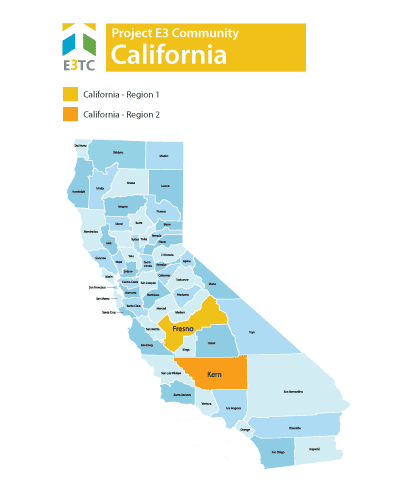California was chosen as a targeted community through the Vocational Rehabilitation Technical Assistance Center: Targeted Communities (VR-TAC-TC) or Project E3. Project E3 partnered with State VR Agencies and local community partners to improve outreach and employment-related services to underserved people with disabilities in this community.
 California is the most populous state in the United States. It is regarded as a global trendsetter in both popular culture and politics, and is the origin of the film industry, the hippie counterculture, and the Internet and personal computer. Fifty-eight percent of the state's economy is centered on finance, government, real estate services, technology, and professional, scientific, and technical business services. It has the 6th largest economy in the world and one of the highest disability rates in the nation.
California is the most populous state in the United States. It is regarded as a global trendsetter in both popular culture and politics, and is the origin of the film industry, the hippie counterculture, and the Internet and personal computer. Fifty-eight percent of the state's economy is centered on finance, government, real estate services, technology, and professional, scientific, and technical business services. It has the 6th largest economy in the world and one of the highest disability rates in the nation.
Agriculture is the primary industry in California’s Central Valley. Primary sources of population growth in this region are people migrating from the San Francisco Bay Area seeking lower housing costs, as well as immigration from Asia, Central America, Mexico, Ukraine and the rest of the former Soviet Union.
Targeted Communities
The state-federal vocational rehabilitation system in California faced many challenges as it strove to serve people with significant disabilities and promote competitive integrated employment. Project E3 provided intensive technical assistance to two cities in California’s Central Valley:

Key Information
Cost of Living
Highest Cost of Living
California has the highest cost of living in the United States apart from Hawaii.
Unemployment
State rate = 4.1%
Poverty Rate
State rate = 16.4%
The high Fresno poverty rate represents very widespread deprivation.
Targeted Populations
Within the targeted communities, Project E3 focused on improving vocational rehabilitation service outcomes for these populations:
These populations were characterized as:
Primary Challenges for Targeted Populations
Research suggested that both of the targeted populations were at increased risk for experiencing trauma. The effects of trauma can reduce participation in employment-related activities and affect vocational rehabilitation service outcomes.
Key Strategies to Address Barriers
Following are some of the key strategies developed and implemented to address the targeted populations' challenges and barriers to employment.
Benefits Counseling: Provided information on Social Security program rules and how employment impacts benefits. The goal was to help people make informed choices about employment.
Career Exploration Group: Discussed employer expectations, learned job and social skills, and explored postsecondary education programs. The goal was to increase participants’ ability to explore and access careers. The group was ultimately peer-led.
Employability Skills Training: Increased participants' ability to work with others and function socially. Taught participants how to adjust to workplace expectations, including written and unwritten rules and social norms.
Financial Literacy Training: Supported people to develop skills and knowledge about personal money management and helped them develop a plan for their financial future.
Trauma Informed Care: Many people experience trauma during their lifetimes. People who have experienced repeated, chronic, or multiple traumas are more likely to experience substance abuse, mental illness, and health problems. Using a trauma-informed approach when working with people who have experienced trauma can make the difference in developing positive relationships and supporting them to reach their work and life goals.
English as a Second Language Training: Connected non-native speakers with language learning opportunities in the community.
California Overview PowerPoint Presentation
Project Outcomes
Project E3 provided California’s state Vocational Rehabilitation agencies and their partners with the skills and competencies needed to effectively and efficiently address barriers to competitive integrated employment and community integration encountered by persons with disabilities in these regions.
Our specific goals for this project were to:
We will leverage promising practices, knowledge, and experience gained from this project to expand employment opportunities for individuals with disabilities from underserved and economically disadvantaged populations throughout California and across the United States.
Continuation and Sustainability Plan
Tools and Resources
University of Illinois Urbana-Champaign Trauma Training Series
- Week One: Overview of Trauma Types, Trauma Rates, and Trauma Informed
- Week Two: Assessments, Screening, and Communication Strategies
- Week 3: Populations At Risk; Risk Factors for Maltreatment
- Week 4: Lasting Impacts of Chronic, Toxic Trauma
- Week 5: Understanding Resilience and Practicing Wellness
- Week 6: Evidence Based Trauma Interventions and Prevention Models
More Information
For further information about these community activities contact:

Dr. David Strauser, Ph.D., CRC
Professor, Department of Kinesiology and Community Health in Rehabilitation Psychology
strauser@illinois.edu


